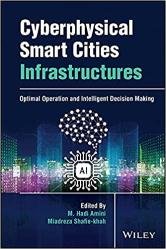Cyberphysical Smart Cities Infrastructures: Optimal Operation and Intelligent Decision Making
- Добавил: literator
- Дата: 21-12-2021, 16:12
- Комментариев: 0
 Название: Cyberphysical Smart Cities Infrastructures: Optimal Operation and Intelligent Decision Making
Название: Cyberphysical Smart Cities Infrastructures: Optimal Operation and Intelligent Decision MakingАвтор: M. Hadi Amini, Miadreza Shafie-khah
Издательство: Wiley
Год: 2022
Страниц: 323
Язык: английский
Формат: pdf (true), epub
Размер: 19.8 MB
Learn to deploy novel algorithms to improve and secure smart city infrastructure.
In Cyberphysical Smart Cities Infrastructures: Optimal Operation and Intelligent Decision Making, accomplished researchers Drs. M. Hadi Amini and Miadreza Shafie-Khah deliver a crucial exploration of new directions in the science and engineering of deploying novel and efficient computing algorithms to enhance the efficient operation of the networks and communication systems underlying smart city infrastructure. The book covers special issues on the deployment of these algorithms with an eye to helping readers improve the operation of smart cities.
The editors present concise and accessible material from a collection of internationally renowned authors in areas as diverse as computer science, electrical engineering, operation research, civil engineering, and the social sciences. They also include discussions of the use of artificial intelligence to secure the operations of cyberphysical smart city infrastructure and provide several examples of the applications of novel theoretical algorithms.
Although Artificial Intelligence (AI) development began in the 1950s, 70 years later, we still do not have fully functional robots walking around. The reason for this has to do with the fact that early AI innovators were limited in technological capability. Things such as processor speed, memory, space, cost, and availability were all issues that these early innovators had to overcome. As developments for the computer became faster, smaller, and cheaper, AI was able to move forward, jumping over hurdles that previously blocked its path. In the beginning of AI programs, many would often be developed to play a board game, such as chess or checkers. These games were limited as far as the rules, and thus easy to learn, but take a significant amount of intelligence to learn and master. By the 1960s, AI had been established and many were working toward defining this new frontier. The best comparison for the growth and development of AI ironically is to that of a human child. When the child is first born, it simply exists. It does not do much other than a few basic functions. However, soon after, the child begins developing motor and verbal skills and interacting with its surroundings. Eventually these motor skills are refined, and the child begins to walk. At the point of mobility, the child's world expands beyond just the three feet surrounding them. Data processing, understanding, and decision making begin to shape in the child. Thus after 70 years, AI is equivalent to a toddler. There are many things that AI can do independently, but it is far from being an independent fully functioning adult right now.
The explosion of advancement in artificial intelligence (AI), sensor technologies like Internet of things (IoT), and wireless communication activates ubiquitous sensing through distributed sensors in various domains of networks that lead us to smart systems in healthcare, transportation, environment, and other relevant branches/networks. Having collaborative interaction among the smart systems connects end user devices to each other, enabling a new integrated entity called smart cities. In the last decade, the IoT devices have been connected among different independent agents and heterogeneous networks as with communication technologies. The connected high performance sensors and end user devices, IoT, are the trigger leveraging the networks in transitioning from urban cities toward smart sustainable cities. The goal of smart cities is to address upcoming challenges of conventional cities by offering integrated management systems with a combination of intelligent infrastructures. In this study, we aim to discover AI solutions, particularly Machine Learning and Deep Learning (DL) approaches rather than others, for smart mobility.
Readers will also enjoy:
Thorough introductions to fundamental algorithms for computing and learning, large-scale optimizations, control theory for large-scale systems
Explorations of machine learning and intelligent decision making in cyberphysical smart cities, including smart energy systems and intelligent transportation networks
In-depth treatments of intelligent decision making in cyberphysical smart city infrastructure and optimization in networked smart cities
Perfect for senior undergraduate and graduate students of electrical and computer engineering, computer science, civil engineering, telecommunications, information technology, and business, Cyberphysical Smart Cities Infrastructures is an indispensable reference for anyone seeking to solve real-world problems in smart cities.
Скачать Cyberphysical Smart Cities Infrastructures: Optimal Operation and Intelligent Decision Making
Внимание
Уважаемый посетитель, Вы зашли на сайт как незарегистрированный пользователь.
Мы рекомендуем Вам зарегистрироваться либо войти на сайт под своим именем.
Уважаемый посетитель, Вы зашли на сайт как незарегистрированный пользователь.
Мы рекомендуем Вам зарегистрироваться либо войти на сайт под своим именем.
Информация
Посетители, находящиеся в группе Гости, не могут оставлять комментарии к данной публикации.
Посетители, находящиеся в группе Гости, не могут оставлять комментарии к данной публикации.
